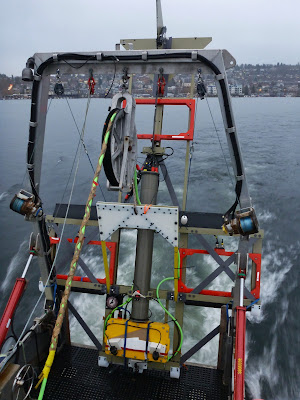 |
| TEMA 3.1 Ready for Sea Trials |
The predecessor to the TEMA was a single sensor towfish we called the BTA. The BTA was purpose build for the Jackson Park munitions clean up project in Ostrich Bay. The BTA was made of wood and plastic and was crude and inefficient compared to the second and third generations of the TEMA.
 |
| BTA on the dock in Ostrich Bay |
 |
| The first TEMA in a surface towed configuration |
Operating the fist TEMA in a submerged mode
In 2011 we started work on the second generation TEMA with the goal of building a towfish that could be used a greater depths, would be more efficient, and easier to tow. The key to all of this was moving the electronics all into a pressure housing that would be part of the towfish, allowing us to tow the TEMA with a single cable and operate a much greater depths. Between other projects it took my colleague and I the better part of a year to design a build. I've written about the construction of the second generation TEMA and about the TEMA electronics pressure housing in previous posts.
The second generation TEMA was a success and was used on two surveys in 2012. In addition to the EM sensors, the TEMA was equiped with a video camera, lights, altimeter, compass, and pitch and roll sensor. The second generation TEMA operated a depths up to 100 meters and could be reliably flown less than a foot above the seafloor.
The second generation TEMA had its fair share of troubles though. Mostly it was too bulky, heavy, and had a tendency to pitch and roll. The only way to combat these problems was to tow the TEMA with a heavy depressor weight and to survey at less than two knots. Even after much spending many, many days fiddling with ballast, floats, and depressor weights, the TEMA would still sometimes roll completely over and even came to the surface upside down more than once.
 |
| The second generation TEMA |
Misbehaving TEMA in Alaska
After a just a few weeks of use I was convinced that I could build a much better towfish using all the same components. I started sketching the design right away, first on paper while on the boat and then in Trimble SketchUp back in the office. I selected and ordered the materials before the holidays so they would be there when I returned. I was able to build the new tow fish entirely by myself in just three weeks.
 |
| TEMA 3.1 SketchUp Model |
This new version of the TEMA is much more streamlined. It requires no depressor weights and weighs less than the previous version. It is built almost entirely of fiberglass but still has UHMW plastic bumpers and skid plates in case it touches down while being towed. Not only did it fly great during its first sea trials but it can also be towed faster than the previous versions.
 |
| The new TEMA on on the back of survey vessel |
 |
| Bow of the TEMA with lead weights |
 |
| TEMA oriented vertically on the stern for transport |
No comments:
Post a Comment